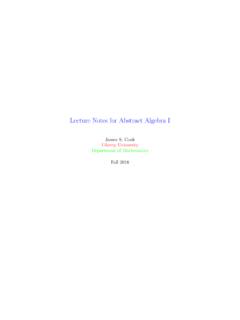Transcription of 5. APPLICATIONS OF DERIVATIVES
1 855. APPLICATIONS OF DERIVATIVES DERIVATIVES are everywhere in engineering, physics, biology, economics, and much more. In this chapter we seek to elucidate a number of general ideas which cut across many disciplines. linearization of a function is the process of approximating a function by a line near some point. The tangent line is the graph of the linearization . Given some algebraic relation that connects different dynamical quantities we can differentiate implicitly. This relates the rates of change for the various quantities involved. Such problems are called related rates problems . The shape of a graph can be ciphered through analyzing how the first and second DERIVATIVES of the function behave. Rolle s Theorem and the Mean Value Theorem are discussed as they provide foundational support for later technical arguments. Fermat s Theorem tells us that local extrema happen at critical points.
2 If a function is increasing on an interval then the derivative will be positive on that same interval. Likewise, a decreasing function will have a negative derivative. These observation lead straight to the First Derivative Test which allows us to classify critical points as being local minimas, maximas or neither. Concavity is discussed and shown to be described by the second derivative of the function. If a function is concave up on an interval then the second derivative of the function will be positive on that interval. Likewise, the second derivative is negative when the function is concave down. Concavity s connection to the second derivative gives us another test; the Second Derivative Test. Sometimes the second derivative test helps us determine what type of extrema reside at a particular critical point. However, the First Derivative Test has wider application. We also discuss the Closed Interval Method which is based on the same ideas plus the insight that when we restrict a function to a closed interval then the extreme values might occur at endpoints.
3 In total, precalculus and college algebra skill is supplemented with new calculus-based insight. Calculus helps us graph with new found confidence. Optimization is the application of calculus-based graphical analysis to particular physical examples. We have to find critical points then characterize them as minima or maxima depending on the problem. As always word problems pose extra troubles as the interpretation of the problem and invention of needed variables are themselves conceptually challenging. This part of calculus allows for much creativity. Often drawing a picture is an essential step to organize your ideas to forge ahead. 86 Finally we discuss limits at infinity. Graphically these limits tell us about horizontal asymptotes. Generally there are many different types of asymptotic behavior, we focus on the basic types. Again this helps us graph better. LINEARIZATIONS We have already found the linearization of a function a number of times.
4 The idea is to replace the function by its tangent line at some point. This provides a fairly good approximation if we are near to the point. How near is near? Well, that depends on the example and what your idea of a good approximation should be. These are questions best left to a good numerical methods course. The linearization of a function at a point is denoted by or simply in this course, The graph of is the tangent line to at . Example : ( linearization can be used to calculate square roots) 88 This example shows that we can calculate good approximations to square roots, even when the computers and their robot slaves turn against us. Example and : 89 These examples just give you a small window into the utility of linearization . You should take our numerical methods course if you want to know more about how to perform these sorts of calculations with care.
5 For APPLICATIONS , the true error in the approximation should be quantified. 90 RELATED RATES Perhaps shockingly related rates problems involve rates of various quantities that are related. We consider two things which are connected through some equation. Both of those things can vary with time so we can consider the quantities as functions of time. Thus, we can differentiate the connecting equation and glean from the technique of implicit differentiation how the rates are related. Let s look at some actual examples (then come back and read this again) Example and : 92 Example and : I find that in almost all word problems the first thing to do is draw a picture. Choose labels for the various quantities that are involved. Then write down any known equations. Once all of that is done then think about how to solve it. The mistake we often make is to try to see the end at the beginning.
6 Sometimes there is something tricky in the middle that we ll not be able to circumnavigate until we have almost all the information in front of us ready to analyze. 93 Example : I think it is fair to say that the difficult portion of these problems is how to set them up. The calculus content is not too bad. You probably have some homework which is not just a twist of one of these examples. That means you need to think about how to set it up on your own. Start with a picture. MAXIMUM & MINIMUMS & GRAPHS This section seeks to use calculus to better understand the shape of various graphs. We need to develop a fair amount of vocabulary. It is important that you assimilate the terms early on so we can understand each other in the examples. Example : : A function has an absolute maximum at if for all . The absolute maximum is in this case. A function has an absolute minimum at if for all.
7 The absolute minimum is in this case. We call the absolute maximum and minimum values the global extrema of , extreme values . : A function has an local maximum at if there exists an open subinterval with and such that for all . The local maximum is in this case. A function has an local minimum at if there exists an open subinterval with and such that for all . The local minimum is in this case. 95 It is easy to see why this Theorem holds true, see Example It s also easy to see why the requirement of continuity is essential. If the function had a vertical asymptote on then the function gets arbitrarily large or negative so there is no biggest or most negative value the function takes on the closed interval. Of course, if we had a vertical asymptote then the function is not continuous at the asymptote. I ll let you consult the text for a proof of the Theorem.
8 Look at the graph and notice we find that wherever there is a local minimum or maximum there is also a horizontal tangent line or no tangent line at all. Points where the derivative is zero or undefined are of critical importance to the analysis of graphs. Hence we define: Our observation that extrema must occur at critical points is known as Fermat s Theorem: The converse of this Theorem is not true. We can have a critical number such that is not a local maximum or minimum. For example, has critical number yet which is neither a local max. nor min. value of . It turns out that (0,0) is actually an inflection point as we ll discuss soon. Another example of a critical point which yields something funny is a constant function; if then for each and every . Technically, is both the minimum and maximum value of . Constant functions are a sort of exceptional case in this game we are playing.
9 Theorem : (Extreme Value Theorem) If is continuous on then attains its absolute maximum of on and its absolute minimum of on for some . There may be multiple points where the extreme values are reached. Definition : We say is a critical number of a function if either or does not exist. If is a critical number then is a critical point. Theorem : (Fermat s Theorem) If is a local extreme value for the function then is a critical number of . 96 Example : Digression: Theorems which we should mention: I am trying to tell a story about how to take apart a function using the derivative and second DERIVATIVES . I admit these Theorems, while interesting, diverge from our main goal in this section. It is customary to cover them around this time in the calculus sequence. To be more careful I would like to spend a couple weeks really taking these apart and making delicate -type proofs.
10 However, there is not time and frankly most of you lack the mathematical maturity for such a journey at this juncture. So I say we state the Theorems, and if you want a proof there are arguments in Stewart which may suffice for now. Again, sorry these appear in such a haphazard fashion in these notes. Rolle s Theorem goes to prove the Mean Value Theorem. Then in Stewart you ll find that the Mean Value Theorem is used to prove that a function increases where its derivative is positive. I think it is geometrically clear. Now perhaps you need to hear those arguments. If so I encourage you to read Stewart carefully, then get another text and read that as well. We will use the Mean Value Theorem in the proof for the Fundamental Theorem of Calculus. Theorem : (Rolle s Theorem) Let be a function such that 1. is continuous on [a,b]. 2. is differentiable on (a,b). 3. Then there exists such that.




